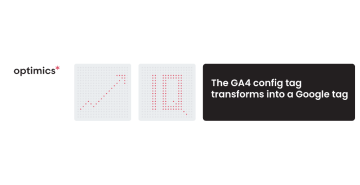From early September, existing GA4 config tags will be transformed into Google tags. If you are using Google Tag Manager, this change will happen automatically, and you don’t need to do anything yourself.
The new Google Tag can be deployed from a template in GTM. You can also reuse a lot of your existing configuration settings and event settings from your GA4 setup.
If you were familiar with the previous template layout, you can already use the Google tag template pretty intuitively. There are, however, some changes, like new key-value pairs for parameters.
It uses a tag ID instead of a measurement ID. Instead of managing multiple tags for different Google product accounts, you can use a single Google tag across your entire website and connect the tag ID to multiple destinations.
Keep in mind that events triggered by a GA4 Event tag will only be sent to the specific GA4 data stream.
There are several benefits to using the Gtag tag instead of the GA4 config tag:
Universal tag: The Gtag tag is a universal tag that can be used to send data to both UA and GA4 properties. This makes it easier for businesses to transition to GA4 without having to change their entire tagging infrastructure.
Simplified code: The Gtag tag is a simplified version of the GA4 config tag. This makes it easier to implement and maintain your tags.
Improved performance: The Gtag tag is designed to improve the performance of your website. It loads faster and uses less memory than the GA4 config tag.
There are also major changes in tag settings. There are two new variables available with Gtag. Event settings and Configuration settings. With event settings, it’s now possible to prepare all event parameters into one variable, instead of each individual tag. Then, the variable is simply loaded into each tag, giving quick and easy access to the parameter library.
The result of this is a big change in parameter initialization. Now, when an event is fired using the new Google tag, the event parameters are reloaded and fresh values are used, unlike in the old GA4 configuration, where when you wanted to refresh the variables, you had to force reload the whole config tag..
Some benefits of this major update stem from the same decision that also produces some complications. This update makes the Google tag system agnostic; Google Tag wasn’t created just for Google Analytics 4. If you want to learn more, we recommend further reading.
This update is a step in the direction of consolidating existing Google technologies under one roof, making the setup easier and more straightforward. Power users of GTM can also take advantage of this update, using GTM to launch non-Google tags a lot easier. The other side of this is the loss of control that comes with this update. Google Tags isn’t as customizable as using GTM to control all of your tags. While that makes the deployment process a lot less bumpy in some cases, advanced setups will still suffer some pain when it comes to setting custom event triggers.
Využijte sílu*
marketingových dat k optimálnímu prodeji
Get in touch
Interested to find out the real potential* of your data?
Drop us your contact details and we will
get back to you shortly.

